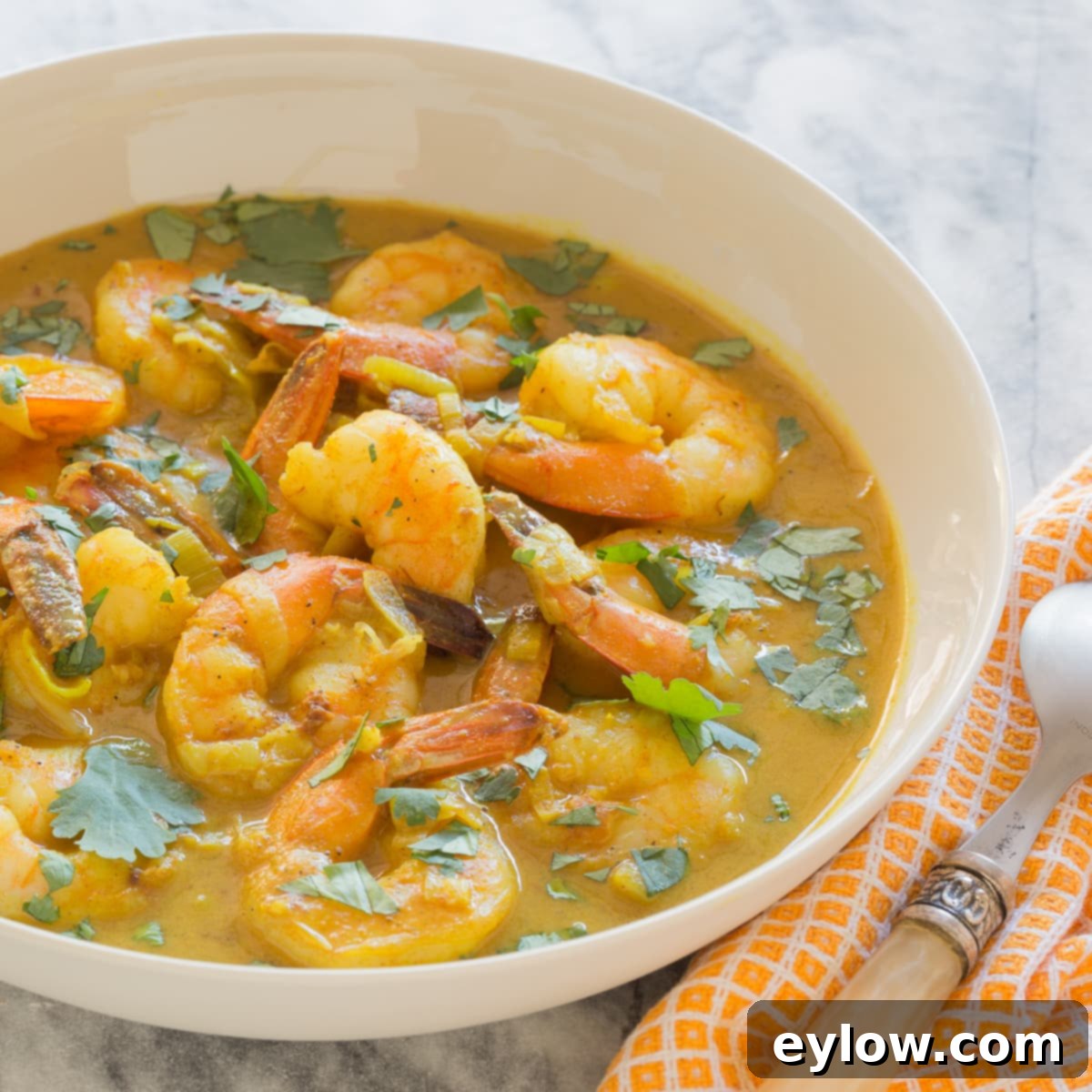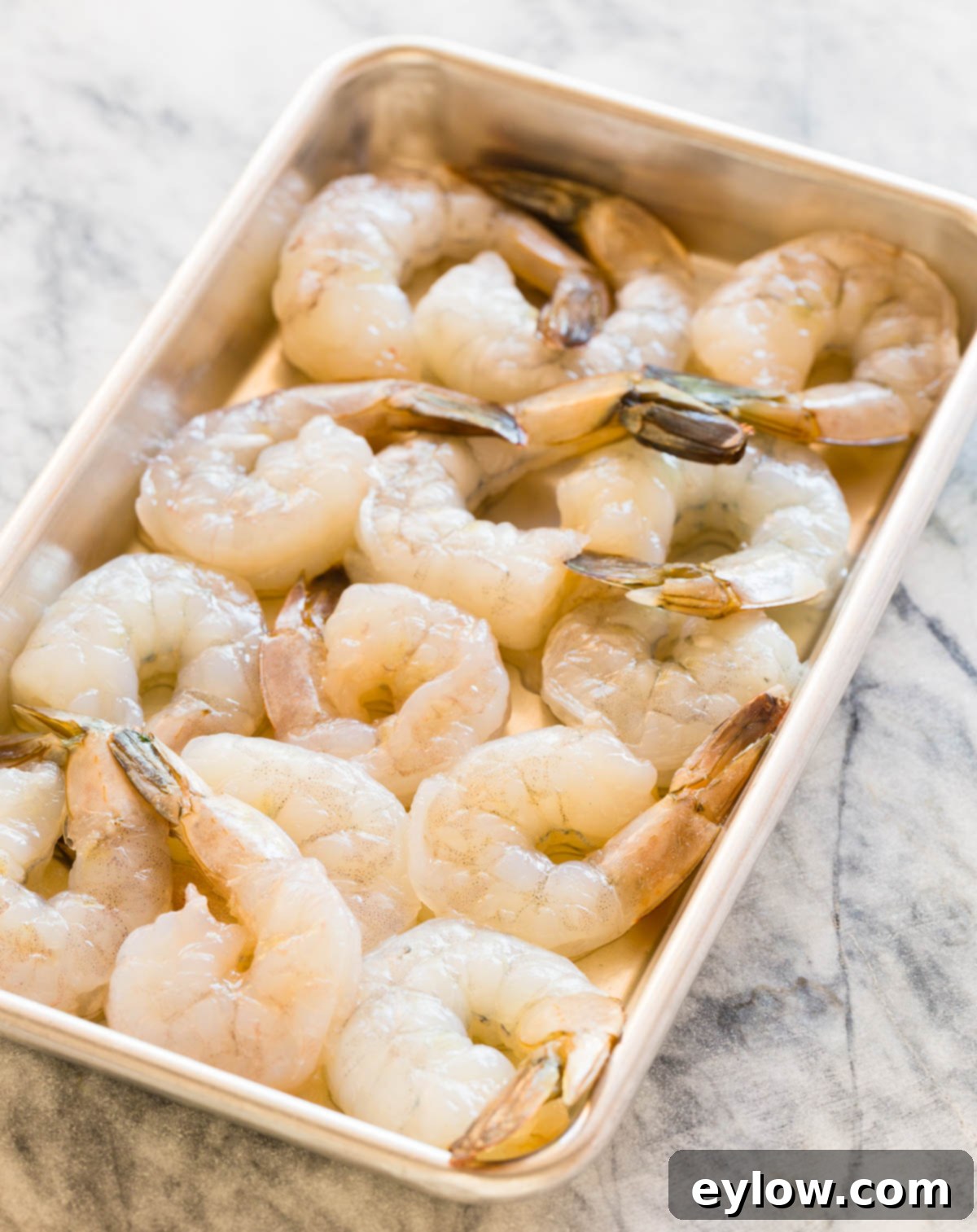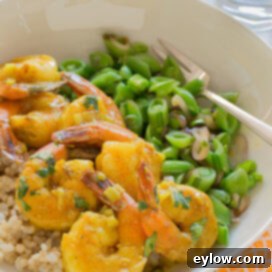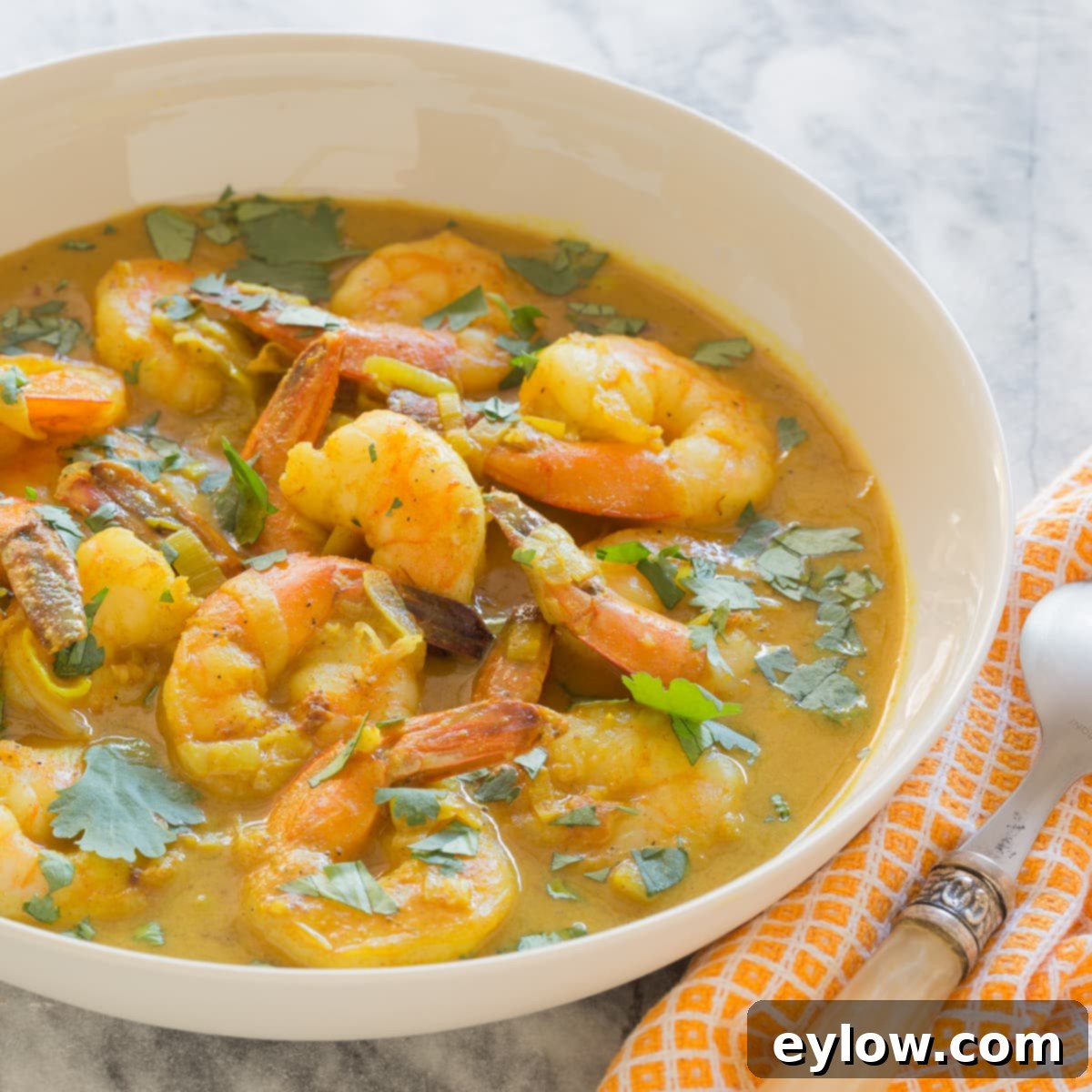Easy & Quick Coconut Shrimp Curry: A Flavorful Weeknight Meal Ready in Minutes
Coconut shrimp curry is truly one of those culinary gems that feels incredibly special and gourmet, yet remains wonderfully straightforward and easy enough to whip up on even the busiest weeknights. Imagine plump, succulent shrimp, cooked to perfection in a matter of minutes, luxuriating in a rich, creamy coconut milk sauce. This sauce is a symphony of flavors, deeply infused with aromatic curry spices, creating a golden, fragrant, and utterly irresistible dish. It’s a vibrant, satisfying meal that effortlessly transports your taste buds to distant shores, offering a much faster and undeniably more delicious experience than any takeout option.

When the clock is ticking and dinner needs to be on the table swiftly, shrimp consistently prove to be my ultimate go-to ingredient. Their remarkable ability to cook in mere minutes, combined with their aptitude for absorbing bold and complex flavors, makes them ideal for fast, flavorful meals. This particular Thai-inspired coconut shrimp curry recipe utilizes full-fat coconut milk to create an exceptionally rich, velvety, and naturally dairy-free sauce. The vibrant golden hue comes from a generous blend of high-quality curry powder, while fresh ginger and garlic contribute an intoxicating aroma and a wonderful depth of savory warmth. A final, crucial squeeze of fresh lime juice at the very end acts as a bright counterpoint, cutting through the richness and perfectly balancing the creamy, spiced coconut sauce, leaving every bite incredibly fresh and zestful.
[feast_advanced_jump_to]
Why You’ll Adore This Easy Coconut Shrimp Curry
This recipe isn’t just another dinner idea; it’s a culinary hack for delicious, nutritious, and quick meals. Here’s why this creamy coconut shrimp curry is bound to become a staple in your kitchen:
- Lightning-Fast Cooking Time: Shrimp are renowned for their quick cooking nature, transforming this curry into a true weeknight champion. From prep to plate, you’ll be amazed at how swiftly this flavorful meal comes together, making it perfect for busy schedules.
- Luxuriously Creamy Coconut Milk Sauce: Indulge in a rich, velvety sauce that offers incredible depth without a drop of dairy. Full-fat coconut milk creates an irresistible base that perfectly cradles the tender shrimp, offering a satisfying and wholesome meal for everyone, including those with dairy sensitivities.
- Exquisite Golden Spice Blend: The carefully selected blend of curry powder, fresh ginger, and fragrant garlic not only imparts a beautiful, inviting golden color but also infuses the entire dish with a warm, complex, and deeply aromatic flavor profile that’s simply captivating.
- A Superior Alternative to Takeout: Why order in when you can create a restaurant-quality meal at home in a fraction of the time and for a fraction of the cost? This dish is simple to prepare and far more satisfying than most delivery options, giving you full control over ingredients and freshness.
- Versatile and Customizable: Whether you prefer a milder taste or a fiery kick, this recipe is incredibly adaptable. Easily adjust the spice level or add your favorite vegetables to make it truly your own.
- Healthy and Wholesome: Packed with lean protein from shrimp and healthy fats from coconut milk, this curry is a nutritious choice that doesn’t compromise on flavor. It’s a meal you can feel good about serving to your family.
Essential Ingredients for Your Coconut Shrimp Curry
Crafting the perfect coconut shrimp curry begins with a selection of fresh, high-quality ingredients. Each component plays a vital role in achieving the dish’s signature flavor and texture:
- Full-Fat Canned Coconut Milk: This is the cornerstone of our creamy sauce. Opt for full-fat varieties for the richest, most decadent texture and deepest coconut flavor. Avoid “light” coconut milk or carton beverages, as they lack the necessary richness and will result in a thinner, less satisfying sauce.
- High-Quality Curry Powder: A versatile blend of spices, curry powder is responsible for the dish’s distinctive golden color and warm, aromatic flavor. You can choose a mild blend for a gentler taste or a hot version if you prefer more heat. The quality of your curry powder significantly impacts the final taste.
- Fresh Onion: Finely chopped, onion forms the foundational aromatic base of the sauce, slowly caramelizing to add a subtle sweetness and complex depth to the curry. Yellow or white onions work best for this purpose.
- Virgin Coconut Oil: Using coconut oil for sautéing not only complements the coconut milk beautifully but also adds another subtle layer of tropical flavor to the dish. If unavailable, a neutral oil like avocado or grapeseed oil can be used.
- Fresh Garlic Cloves: Minced or finely grated fresh garlic is indispensable, contributing bold, pungent, and savory notes that are essential for an authentic curry flavor. Fresh is always best for maximum impact.
- Fresh Ginger: Finely grated fresh ginger or a good quality ginger paste provides a wonderful zing, warmth, and a slightly peppery undertone that perfectly balances the creamy sauce. It’s a key player in the curry’s aromatic profile.
- Large Raw Shrimp: The star of the show! We recommend large raw shrimp, preferably wild-caught for superior flavor and texture. Ensure they are peeled and deveined for ease of preparation and consumption.
- Fresh Cilantro (Optional, but recommended): A sprinkle of freshly chopped cilantro at the end adds a burst of vibrant color and a bright, herbaceous finish that elevates the entire dish. It’s an excellent garnish for both visual appeal and flavor.
- Lime Juice (Not listed above, but crucial): A fresh squeeze of lime juice at the end is vital for brightening the flavors and cutting through the richness of the coconut milk, ensuring a well-balanced and refreshing taste.
Please refer to the detailed recipe card below for precise measurements, and don’t forget to season generously with salt and pepper to taste.
Chef’s Tip: Why Choose Wild-Caught Shrimp
Shrimp reigns as the most popular seafood in the U.S., yet a staggering 90% is imported, with only a tiny fraction undergoing inspection. Farmed shrimp often raise concerns regarding the use of antibiotics, pesticides, and their environmental impact. Wild-caught shrimp, conversely, are generally considered a cleaner, more sustainable, and undeniably superior choice in terms of flavor. Their taste is often sweeter and their texture firmer. Whenever possible, making the conscious decision to choose wild-caught shrimp not only supports healthier oceans but also guarantees a better-tasting curry.
Exciting Substitutions and Flavorful Variations
This coconut shrimp curry recipe is incredibly versatile, allowing for creative adjustments to suit your dietary needs or flavor preferences. Feel free to experiment and make it your own:
- Amp Up the Heat: If you’re a fan of spicy food, it’s easy to kick things up a notch. Add a pinch of cayenne pepper, a generous sprinkle of red chili flakes, or a thinly sliced fresh bird’s eye chili along with the garlic and ginger. You can also finish with a drizzle of chili oil for an extra layer of heat.
- Curry Paste for a Bolder Flavor: For a deeper, more authentic Thai flavor profile and an added layer of spice, swap the curry powder for 1½-2 tablespoons of red Thai curry paste. Be sure to sauté the paste with the onion, garlic, and ginger for a minute or two before adding the coconut milk to toast the spices and enhance their aroma.
- Milder, Sweeter Base: If you prefer a milder and slightly sweeter base flavor, consider using finely chopped leeks instead of onion. Leeks offer a more delicate allium flavor that can be very appealing, especially for those sensitive to the pungency of onions.
- Add Vegetables: Boost the nutritional content and volume of your curry by incorporating quick-cooking vegetables. Snap peas, bell peppers (sliced), spinach, thinly sliced carrots, or broccoli florets are excellent additions. Add them along with the shrimp, or during the last few minutes of simmering, to ensure they remain crisp-tender.
- Other Proteins: While this is a shrimp curry, boneless chicken breast or thighs, cut into bite-sized pieces, make a fantastic substitute. If using chicken, brown it first in the coconut oil before adding the aromatics, then simmer in the sauce until fully cooked through (about 10-15 minutes, depending on size), before adding the coconut milk mixture. Firm tofu or chickpeas also work well for a vegetarian option; add them to the simmering sauce until heated through.
- Herbal Twist: While cilantro is traditional, you can also try fresh basil leaves (especially Thai basil) or a combination of both for a different aromatic twist.
Chef’s Tip: Deciphering Shrimp Sizes
Shrimp are typically sold by count per pound, a number that indicates how many individual shrimp you’ll find in one pound. For instance, “Jumbo” sizes like 16-20 count mean there are 16 to 20 shrimp per pound, while “Large” or “Extra Large” might be 21-25 count. Smaller shrimp (e.g., 31-35 count) cook even faster and are generally less expensive, making them a budget-friendly option. Whenever possible, aim to buy shell-on shrimp. The shell acts as a natural protector, preserving the shrimp’s delicate meat and flavor during storage and thawing. Peeling and deveining them yourself ensures the freshest taste and best texture. However, for those short on time, pre-peeled and deveined shrimp are a perfectly acceptable and convenient shortcut, just be mindful of their quality.

Mastering the Art of Thawing Shrimp
Most shrimp available on the market are flash-frozen shortly after harvest, often sold as IQF (individually quick frozen). This method preserves their freshness and texture remarkably well. What often appears to be “fresh” shrimp at the seafood counter has usually been thawed from frozen. Proper thawing is crucial to maintain the shrimp’s texture and prevent it from becoming rubbery or watery when cooked.
- The Quick Thaw Method (for when you’re in a hurry): Place your frozen shrimp in a sealed, waterproof bag (like a freezer-safe zip-top bag). Submerge the bag in a bowl of cold tap water. Change the water every 20-30 minutes to keep it cold and facilitate thawing. Depending on the size of your shrimp, this method typically takes about 30-45 minutes. Avoid using warm or hot water, as this can start to cook the shrimp unevenly and compromise their texture.
- The Best Thaw Method (for optimal texture and flavor): For the absolute best results, plan ahead and thaw your shrimp slowly in the refrigerator overnight. Place the frozen shrimp in a single layer on a rimmed baking sheet or in a colander set over a bowl. The rimmed sheet or bowl will catch any liquid as the shrimp thaw, preventing mess and keeping them from sitting in water. This gentle, slow thawing process helps to preserve the shrimp’s delicate texture and flavor.
Once thawed, always pat the shrimp thoroughly dry with paper towels before cooking. Removing excess moisture promotes better searing and ensures they cook evenly and brown beautifully.

Crafting Your Delicious Coconut Shrimp Curry: A Step-by-Step Guide
The beauty of this coconut shrimp curry lies in its speed, but a little pre-preparation (mise en place) makes all the difference. Shrimp cook incredibly quickly, yielding tender results when gently simmered in the spiced coconut milk. Having all your ingredients prepped and ready before you start cooking ensures a smooth, stress-free process.
Make Ahead Tip: To further streamline your cooking, you can whisk together the coconut milk and curry powder mixture, and finely chop the onion, garlic, and ginger a day in advance. Store the sauce in an airtight container in the fridge and the aromatics in separate small containers. When it’s time for dinner, the actual cooking process will come together in mere minutes!
- Prepare the Flavorful Sauce: In a medium bowl or a large jar with a lid, whisk together the full-fat coconut milk, curry powder (or red Thai curry paste if using), and a pinch of salt until the mixture is completely smooth and well combined. If using a jar, simply shake vigorously until uniform. Set this aside. This ensures the spices are evenly distributed and ready to infuse the sauce.
- Chop the Aromatics: Finely chop your onion. Mince or finely grate the fresh garlic cloves and ginger. The finer they are, the more readily their flavors will release into the oil. Have these ready in small bowls.
- Build the Flavor Base: Heat the coconut oil in a large skillet or deep sauté pan over medium heat. Ensure the pan is large enough to hold all the shrimp in a single layer. Add the chopped onion and cook, stirring occasionally, until it softens and becomes translucent, which usually takes about 2-3 minutes. Then, stir in the minced garlic and grated ginger and cook for another 30-60 seconds, until fragrant. Be careful not to burn the garlic.
- Gently Simmer the Shrimp: Add the peeled and deveined shrimp to the pan, arranging them in a single layer if possible. Cook for 1-2 minutes until they just begin to turn pink on one side. Flip the shrimp over, then immediately pour the prepared spiced coconut milk mixture over them. Bring the sauce to a gentle simmer, then reduce the heat to low and cover the pan. Continue to cook for another 3-5 minutes, depending on the size of your shrimp, until they are opaque, firm, and thoroughly cooked through. Avoid overcooking!
- Season and Serve: Once the shrimp are perfectly cooked, remove the pan from the heat. Taste the curry sauce and adjust the seasoning with additional salt or pepper if needed. If desired, a final squeeze of fresh lime juice can brighten the flavors beautifully. Garnish generously with freshly chopped cilantro before serving hot.
Chef’s Tip: If your ingredients are prepped and ready to go, the actual cooking time for this delightful curry is incredibly short, making it perfect for a last-minute meal.
Chef’s Tip: Achieving Perfectly Cooked Shrimp
The key to tender, juicy shrimp is understanding their quick cooking time. Shrimp cook in just a few minutes, and smaller varieties will cook even faster. The most common mistake is leaving them on the heat for too long, which results in a rubbery, unpleasant texture. Shrimp are perfectly done when they turn uniformly pink and opaque, and any grayish, translucent areas have disappeared. The moment they reach this stage, it’s crucial to remove them from the heat immediately. Even an extra minute can transform them from succulent to tough. Keep a close eye on them!

Delightful Serving Suggestions
This creamy coconut shrimp curry is a wonderfully versatile dish that pairs beautifully with a variety of accompaniments. The goal is to choose sides that complement its rich flavors and creamy texture:
- Rice Varieties: The classic choice! Serve the shrimp and luxurious coconut curry sauce over fluffy white jasmine rice for a traditional experience, nutty brown rice for added fiber and chew, or even wild rice for a gourmet touch.
- Grain Alternatives: For a lighter or gluten-free option, consider quinoa, couscous, or a flavorful cauliflower rice. The cauliflower rice will absorb the sauce beautifully without adding extra carbs.
- Fresh Garnishes: Enhance both the visual appeal and the flavor profile with fresh garnishes. A generous sprinkle of freshly chopped cilantro or thinly sliced green onions adds a burst of freshness and color. A final squeeze of fresh lime juice over individual servings is essential, as its acidity brightens and balances the rich, creamy flavors.
- Vegetable Sides: To balance the richness of the curry, pair it with a simple tossed green salad with a light vinaigrette. Alternatively, quick-cooking vegetable sides work wonderfully. Think simple blanched green beans, steamed broccoli, sautéed snap peas, or roasted asparagus. These add freshness, texture, and additional nutrients to your meal.
- Warm Flatbreads: For a more interactive and comforting meal, serve the curry with warm naan bread, roti, or paratha. These soft breads are perfect for soaking up every last drop of the delicious sauce.
Storage & Freezing Guidelines
Proper storage is essential to maintain the quality and safety of your leftovers. Here’s how to handle your delicious coconut shrimp curry:
- Refrigerate: Any leftover coconut shrimp curry should be transferred to an airtight container and stored in the refrigerator. It will keep well for up to 3 days. When reheating, do so gently on the stovetop over medium-low heat. Stir occasionally until warmed through. Be very careful to avoid aggressively boiling or overcooking the shrimp again, as this will lead to a rubbery texture.
- Freezing: Freezing this dish is generally not recommended. Shrimp, when frozen and then reheated, tend to become rubbery and lose their desirable tender texture. Furthermore, the coconut milk-based sauce can often separate or become grainy upon thawing and reheating, compromising its creamy consistency. This dish is truly at its best when enjoyed fresh, shortly after it’s prepared. If you anticipate having leftovers, consider preparing a smaller batch or enjoy it within the recommended refrigeration period.
Common Questions About Coconut Shrimp Curry
For the richest, most luxurious, and creamiest sauce, always opt for canned full-fat coconut milk. Its higher fat content creates that desirable velvety texture and deep coconut flavor. Light coconut milk can be used if you’re looking to reduce calories, but be aware that the sauce will be thinner and less rich. Absolutely avoid cartons of coconut beverage (often found in the dairy alternative aisle), as these are much too thin and watery for a curry sauce.
Yes, absolutely! Boneless, skinless chicken breast or thighs make excellent substitutes. Cut the chicken into bite-sized pieces (about 1-inch cubes). If using chicken, you’ll need to adjust the cooking process slightly: brown the chicken pieces in the coconut oil before adding the onion, then simmer them in the sauce for a longer duration (typically 10-15 minutes, or until fully cooked through) before adding the coconut milk mixture. Firm tofu, tempeh, or even chickpeas are also great plant-based alternatives; add these directly to the simmering sauce until heated through and coated in flavor.
Using frozen shrimp is perfectly fine and very common! In fact, most “fresh” shrimp sold at markets have already been thawed from frozen. The key is to thaw them properly. You can either thaw them overnight in the refrigerator on a rimmed baking sheet (to catch any liquid), which is the best method for preserving texture. Alternatively, for a quicker thaw, place the frozen shrimp in a sealed bag and submerge it in a bowl of cold water for about 30-45 minutes, changing the water every 15-20 minutes. Always pat thawed shrimp dry before cooking to ensure better searing and flavor.
If your curry sauce turns out thinner than desired, there are a few simple tricks. First, ensure you’ve used full-fat coconut milk. You can also allow the sauce to simmer gently for an additional 5-10 minutes (after removing the shrimp to prevent overcooking them), which will allow some of the liquid to evaporate and the sauce to thicken naturally. Another option is to create a cornstarch slurry: mix 1 tablespoon of cornstarch with 2 tablespoons of cold water, then slowly whisk it into the simmering sauce. Cook for 1-2 minutes until thickened.
While the flavors of this curry could theoretically work in a slow cooker, it’s generally not recommended for shrimp. Shrimp cook so quickly that they would become extremely overcooked and rubbery in a slow cooker. This recipe is designed for fast stovetop cooking. If you wish to use a slow cooker, we suggest using chicken or a plant-based protein instead of shrimp, adding the protein at the beginning and the coconut milk towards the end of the cooking cycle.
Explore More Quick & Delicious Shrimp Recipes
Shrimp’s quick-cooking nature makes it an absolute hero for fast dinners during busy weeks! If you loved this coconut shrimp curry, you’ll definitely want to try these other fantastic shrimp recipes that promise flavor and efficiency:
- Zesty Garlic Shrimp Skewers (Grilled or Oven)
- Easy Baked Lemon Garlic Shrimp Scampi
- Authentic Tom Yum Thai Soup With Shrimp
- Grilled Tequila Lime Shrimp with Fresh Herbs
Did You Make This Delicious Recipe?
We absolutely love hearing from you! If you’ve had the pleasure of making this easy coconut shrimp curry, please take a moment to leave a comment below. Your feedback and personal experiences are incredibly valuable, not only to us but also to other readers who are looking for their next favorite meal. Don’t forget to leave a star rating – it truly helps others discover and enjoy this fantastic recipe!
📖 Recipe

Creamy & Quick Coconut Shrimp Curry
Sally Cameron
Pin Recipe
Ingredients
- 2 cups canned full-fat coconut milk
- 2 ½ teaspoons curry powder (mild or hot, to taste)
- 1 tablespoon extra virgin coconut oil
- ⅓ cup onion, finely chopped (yellow or white)
- 2 garlic cloves finely chopped or zested
- 1 ½ teaspoons ginger finely grated or ginger paste
- 1 ½ pounds raw peeled deveined shrimp (21-25 size recommended)
- Salt and freshly ground black pepper to taste
- 1-2 tablespoons chopped fresh cilantro (optional, for garnish)
- 1 fresh lime, cut into wedges (for serving)
Optional swap for curry powder
- 1 ½-2 tablespoons red Thai curry paste
Instructions
-
In a medium bowl, whisk together the canned full-fat coconut milk and curry powder (or red Thai curry paste, if using) until completely smooth. You can also achieve this by placing the ingredients in a large jar with a tight-fitting lid and shaking vigorously, or by using a blender on a low setting. Set this creamy mixture aside.
-
Heat the coconut oil in a large sauté pan or skillet over medium heat. Ensure your pan is spacious enough to accommodate all the shrimp in a single layer. Add the finely chopped onion and cook, stirring occasionally, until it softens and becomes translucent, which usually takes about 2-3 minutes. Next, stir in the minced garlic and grated ginger and continue to cook for an additional 30 seconds to 1 minute, until highly fragrant. Be careful not to let the garlic burn.
-
Add the raw, peeled, and deveined shrimp to the pan, arranging them as flat as possible in a single layer. Cook for just 1-2 minutes until they turn pink on one side. Flip the shrimp over, then immediately pour the spiced coconut milk mixture you prepared earlier over the shrimp.
Bring the contents of the pan to a gentle simmer. Once simmering, place a lid on top, reduce the heat to low, and continue to cook for another 3-5 minutes, depending on the size of your shrimp. The shrimp are done when they are firm, fully pink, and opaque throughout. Remove from heat immediately to prevent overcooking. Serve the curry hot, sprinkled with freshly chopped cilantro (if desired), and a refreshing squeeze of fresh lime juice over each portion.
